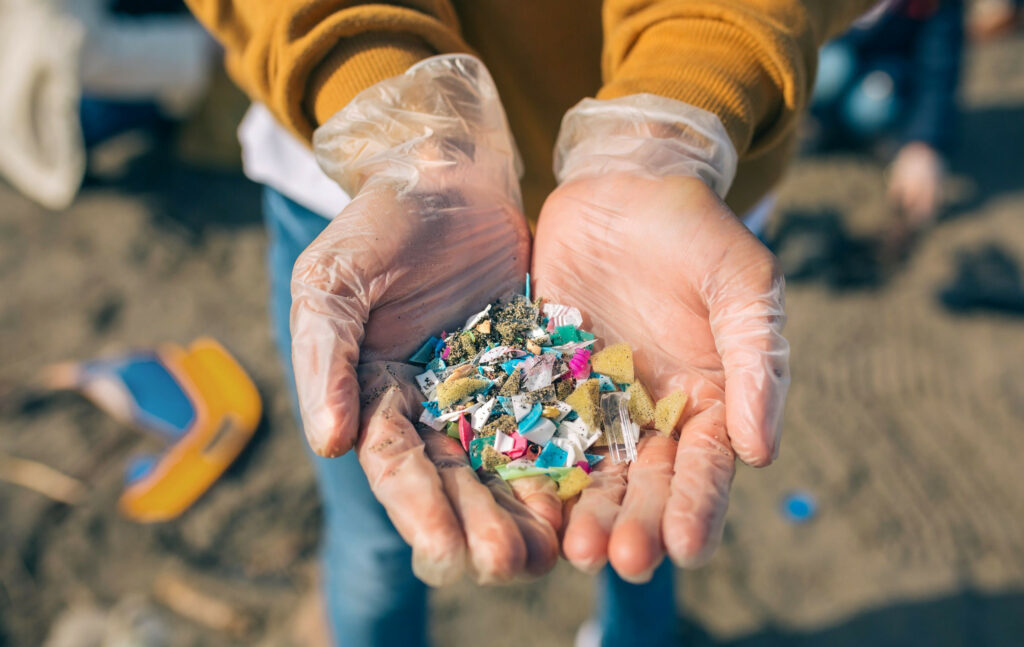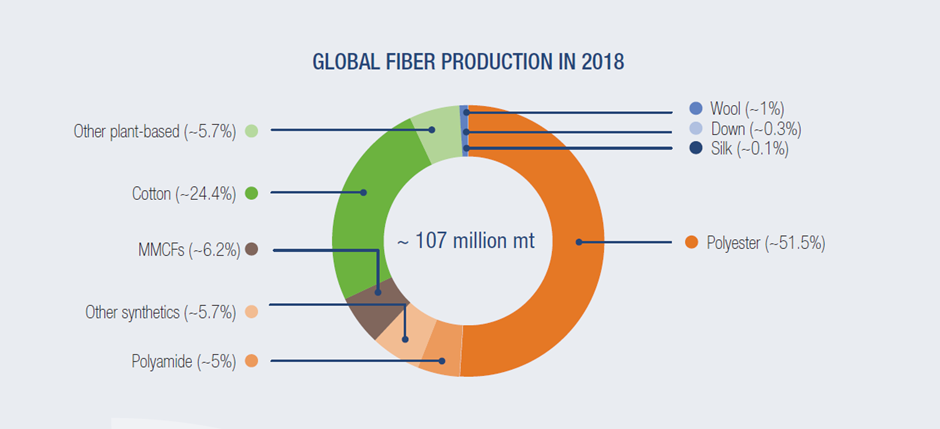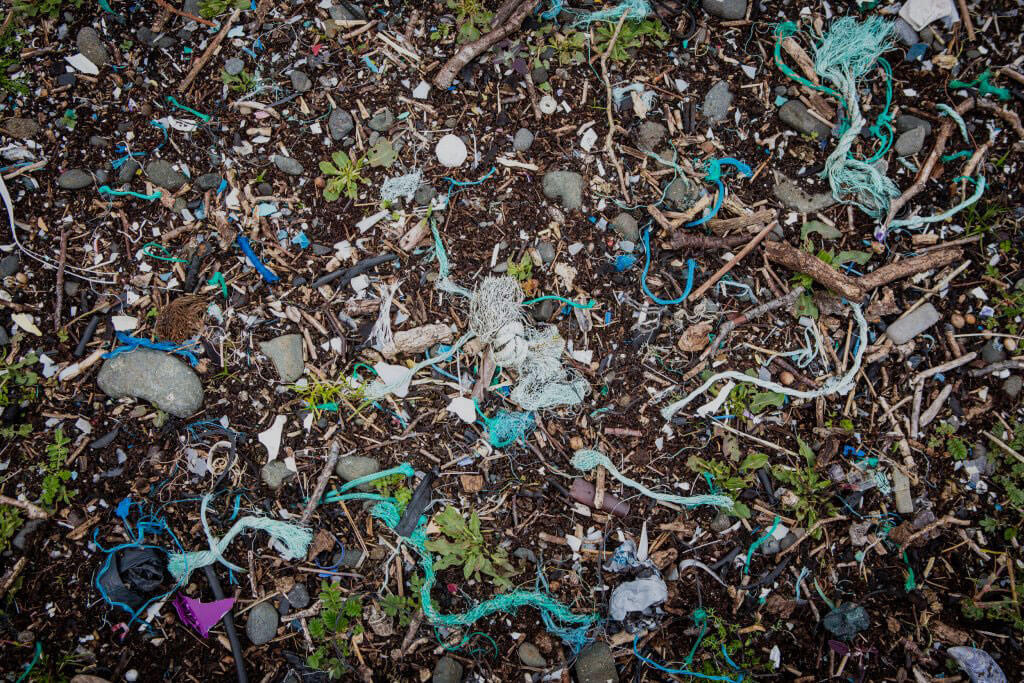
Large quantities of plastic waste find their way into the environment every year and microplastics now contaminate the entirety of our planet, from the summit of Mount Everest to the deepest oceans. It is a rapidly increasing concern throughout the world and it is now considered one of the most urgent environmental and ecological issues, after global warming and biodiversity loss (1). Recent studies have even found traces of microplastics in our blood (blood samples were collected from the public) and the health consequences of this are still unknown (2). Since the middle of the 1990s, synthetic fibres have dominated the textile industry when they overtook natural fibres such as cotton. This fibre category made up approximately 62% of the global fibre production, with around 66.6 million tonnes of synthetic fibres in 2018 (3).

Global fibre production in total stood at 107 million tonnes in 2018 and is expected to reach 145 million tonnes in 2030 (4). Around 50% of our clothing is made from synthetic materials and it is estimated that up to 700,000 fibres can be released from our synthetic clothes in a typical wash (5). If the fashion industry continues as it is, between the years 2015 and 2050, 22 million tonnes of microfibres will enter our oceans and environment (6).
What Exactly are Microplastics & How is the Textile Industry Related?
Microplastics are small pieces less than 5 mm made of synthetic polymers that are becoming the most widespread and persistent contaminant in the environment. Textiles are the largest source of primary microplastics, accounting for 34.8% of global microplastic pollution (7). Microfibres are a type of microplastic released with the washing of synthetic clothing, clothing which is made from plastic such as polyester and acrylic. These fibres detach from our clothing during washing and enter wastewater streams. Once this wastewater enters sewage treatment facilities, given that the microfibres are so small, many pass through the filtration processes and make their way into our rivers and seas. They are then easily ingested by marine animals which will have (as of yet unknown but likely) detrimental effects on the species and the entire marine ecosystem.
Additionally, microfibres can absorb chemicals present in the water or sewage sludge, such as polychlorinated biphenyls (PCBs) and carcinogenic Persistent Organic Pollutants (PoPs). They can also contain chemical additives, from the manufacturing phase of the materials, such as plasticisers, flame retardants and antimicrobial agents (chemicals that prevent the growth of microorganisms). These chemicals leach from the plastic into our oceans and can even enter the bloodstream of animals that ingest these microfibres. Once ingested, microfibres can cause blockages of the gut, physical injuries, hormonal disruption, changes to oxygen levels in cells, altered feeding behaviour and reduced energy levels, which ultimately impacts growth and reproduction (8). This results in the disruption of the balance of whole ecosystems, with the impacts travelling up the food chain and sometimes making their way into the food we eat.
How do Microplastics Enter our Food Chain?
Though much of the research to date on the impacts of microplastics in the environment has had a marine focus, it is now estimated that microplastics have accumulated in soil in quantities that exceed the amounts found to be burdening the ocean and aquatic life (9).
Soil, particularly arable soil (meaning soil which is suitable for growing crops), has become a major and permanent sink for plastic (10). The sources for this contamination includes wastewater, manufacturing industries (which includes the textile industry), agricultural pollution (mulching) and landfills. As outlined in Nanomaterials (2021), the level of plastic pollution from wastewater treatment plants is extreme. Wastewater treatment plants are currently between 65-90% efficient at filtering microfibres (11). Research and innovations into improving the efficiency of capturing microfibres in wastewater treatment plants is essential to prevent them escaping into our environment, with approximately 7.76 million tonnes of this form of plastic waste found on agricultural land. Plastic has been reported both in surface and subsurface soil and can be absorbed by plants, particularly through root hairs (12), resulting in their accumulation in the environment and our food streams, impacting our health in ways which are not yet fully understood.

What Measures can be taken to stop this?
To come back to the textile industry, more responsibility for minimising future microfibre releases needs to be put into action. It is up to fashion brands and textile manufacturers to take microfibre release into consideration at the design and manufacturing stages of a garment and designers should consider minimising the environmental impact of a synthetic garment (13). This can be achieved by using textiles which have been tested to ensure minimal release of synthetic microfibres, ensuring the product is durable so it remains out of landfill as long as possible and consideration into the recyclability of the garment, while aiming for a circular lifecycle. During the manufacturing process, methods that can be applied to reduce microfibre shedding such as brushing the material, using laser and ultrasound cutting, coatings and pre-washing garments should be considered. The length of the yarn, type of weave, and method for finishing seams may all affect shedding rates. The necessity for more research into this is clear, with textile and fashion brands taking the lead.
Conclusions
To conclude, it is necessary for strong government legislative measures to be put into force in order to reduce microplastic contamination in our environment, and to protect animal and human health. Collaboration across multiple industries is also necessary to tackle microfibre pollution. It will be necessary for other sectors such as detergent manufacturers, wastewater treatment plants, agriculture and the recycling industry to come together to help reduce microfibre pollution. The European Commission recently launched a call for public consultations on this topic, with the aim of a possible policy to tackle microplastic pollution. The deadline is the 17th of May 2022 and we are pleased to say that ZWAI contributed to this consultation which was in the form of a questionnaire. Perhaps the urgency of this issue is catching on and we will begin to see some real action soon. The European Environmental Agency (EEA) have produced an excellent report on the topic of microplastics contamination from textiles, check it out here:
Want some tips to avoid microplastics in your food? Check out this video on Plastics in Food by NowThis Earth.
